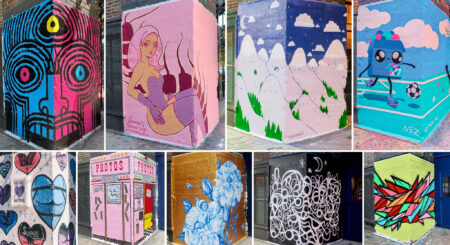Never limited to a single outlet for artistic expression, Jack Walls has been creating—and inspiring—art as an elusive, yet ever-present, fixture of New York’s downtown art scene for decades. Fondly known as an “inside outsider,” Jack lived and worked in the West Village in the early ’80s after leaving his hometown Chicago for a stint in the Navy. He was a muse of well-known photographer Robert Mapplethorpe and traveled in circles with musician Patti Smith and photographer Ryan McGinley. Later, the next generation of creators, including graffiti artist Dash Snow, looked to Jack for artistic mentorship, guidance, and camaraderie.
Jack’s poetry, writing, drawings, and collages are richly influenced by his life experiences, travels, and artist community, among other forces. We connected with him after the launch of his new Artist Shop to learn about his inspiration, process, artistic themes, and more.
Though you weren’t formally trained as a fine artist, you grew up drawing and reading. What kinds of things were you interested in creating as a child? What stories do you remember sticking with you?
In some ways, I feel that I am trained formally. Having always drawn from an early age helped a lot. My two older brothers (when we were kids) both knew how to draw very well. So both of them drew far better than me, I learned from them. During the summertime breaks from elementary school, we would sit around the kitchen table late into the night drawing. I would fall asleep there at the table, head down still clutching the pencil, or so I’ve been told. I sort of remember this happening, I was then around 6 or 7 years old.
You’ve never confined your work to one medium. At what times in your life have you felt more compelled to draw, write, collage, paint?
I took my drawing abilities for granted for many many years. I was more interested in reading and writing, only because that’s something that can be done anywhere at anytime for the most part. It was a convenient creative outlet. I had my first fine art solo exhibition when I was 50 years old. Those were the Mapplethorpe sourced ADA collages. Having done that and not wanting to be pigeonholed, a couple of years later I did my “Ebony Prick of the White Rose’s Thorn” show. Which was my nod to my interest in literature.
On any given day, what does your artistic process look like? How do you decide what form your work will take for the day? Do you find yourself moving across projects, or deep diving into one pursuit for extended periods of time?
My day usually starts out with me writing, even if it’s just one sentence, sometimes it’s just a single word that pops into my head. Then, if I have an upcoming show, I’ll work on that. Even if there isn’t an upcoming show on the horizon, I still work as if there is. I curate shows in my head, that could possibly happen. I’m always sitting on at least one or two shows, just in case.
After leaving Chicago as a young man you joined the Navy, which you’ve said you didn’t do out of patriotism but out of a need to see the world. How did your experience in the Navy influence your art or writing, if at all?
I’m not sure if my experiences in the Navy influenced my desire to be a writer, but it didn’t hurt.
You’ve often been a muse and source of inspiration for your fellow artists, including your late partner, photographer Robert Mapplethorpe. What’s the experience of being in front of the camera like for you? How does it inform your work?
I’m not a photographer, but I do love photography. Which is why I tend to hang out with photographers so much. Some have accused me of being a photographer too, because of my Instagram feed. I’d like to curate a Mapplethorpe and Ryan McGinley joint exhibition sometime down the road though. Actually, I’ve never enjoy being in front of the camera, being photographed.
How do you balance what inspires your art and what you feel drawn to create? What do you do to refresh your artistic drive when you’re not feeling inspired?
I’m always inspired, it takes money to make art. You can be inspired all you want, but if the money’s not available to execute your thoughts, that’s very uninspiring. When money is the determining factor in your important creative decisions, it can be a drag. That’s why I never confine my work to one medium.
How has your writing evolved since you studied at Chicago Filmmakers, wrote “The Ebony Prick of the White Rose’s Thorn,” and the screenplay Somebody’s Sins?
Writing is like everything else, the more you do it, the better you get.
How does memory and memoir fit into your writing? What does your writing process look like?
Writing one’s memoir comes from memory. Where as I feel an autobiographical piece of writing, or biography, should be strongly rooted in fact, not as how you see it. I don’t view my writing as autobiography, I view it as how I see it.
You write and create in repeated themes (grief and romanticism being two). Do you see a larger narrative to your work or style as an artist?
That’s when the larger narrative becomes autobiographic, when it begins to become personal to the reader. I don’t feel you have to hit everyone over the head with your life story. If the writing (art) is pure, it will shine through.
What advice do you have for up-and-coming artists?
Always go against the grain, don’t try to be popular, unpopularity has its own rewards. Just work, and work hard.





